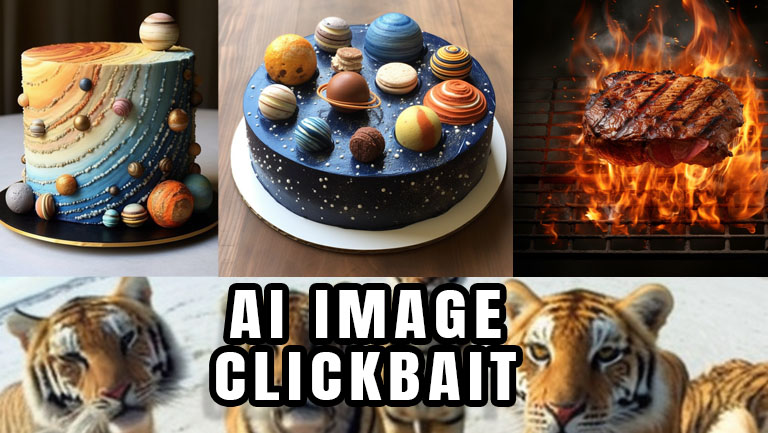AI-Generated Clickbait

You have probably noticed an increase in amazing images on the internet lately. Cakes that seem out of this world, animals taking amazing selfies, and impossible landscapes are just some of the images that have been exploding on social media feeds. Are people taking better images? Not really. It’s probably AI-Generated images.
How AI-Generated Images Are Capturing Our Attention
The age of artificial intelligence has brought about significant advancements, including the creation of highly realistic images. However, as with any new technology, these innovations can be misused. In recent years, AI-generated images have become a common tool for clickbait on social media platforms. In this blog post, we’ll delve into the world of AI-generated images, how they’re used to manipulate our online behavior, and what we can do to protect ourselves from falling prey to these tactics.
Luring You In: How AI-Generated Images Are Used as Clickbait
You might be wondering, how exactly are AI-generated images being used as clickbait on social media platforms? Well, let’s take a closer look at some of the tactics employed by content creators to grab our attention.
First off, you’ve probably come across those fantastical landscapes that seem too beautiful to be true. You know, the ones with purple skies, floating islands, or mountains that look like they’re made of candy. These images are often generated using AI algorithms that can create entirely new, surreal scenes by combining elements from various sources. The result? A stunning, otherworldly image that’s just begging for you to click and see more.



Another common type of AI-generated clickbait involves animals and creatures. Either it’s amazing photography that seems impossible to get or strange creatures. We’re talking about animals that look like they belong in a sci-fi movie, with features and colors that defy the laws of nature. These AI-created critters are designed to pique our curiosity, making us wonder if such a creature could actually exist. Before we know it, we’ve clicked on the link, only to find that the image was a clever, artificial creation.



Amazing food creations and food photography have also been swarming social media posts. Images that make you want to know who baked that and where you can get it. Most of these images don’t cite where they came from and that should be a clue they aren’t real.
AI PEOPLE
Finally, let’s talk about those eerily realistic human faces that have been popping up all over social media. These AI-generated portraits are so lifelike, it’s hard to believe they’re not real people. Content creators often use these faces to accompany enticing headlines, making us feel more connected and intrigued by the story. But once we click through, we quickly realize that the person in the image doesn’t actually exist.
So, why are these AI-generated images so effective at capturing our attention? It all comes down to our innate human curiosity. We’re naturally drawn to things that are novel, strange, or mysterious. AI-generated images exploit this curiosity by presenting us with visuals that seem almost too incredible to be real. And, let’s face it, we’ve all had that moment of weakness where we just had to click and find out more.
We aren’t against AI imagery. It can be a great thing. But people who use it should be honest that that is what the images are. See if they tell you where the image came from. More often than not the image will be posted without any references to its creation.
These deceptive images contribute to a culture of inauthenticity, where it becomes increasingly difficult to distinguish fact from fiction. Moreover, they can lead to the spread of misinformation, as users might share these images without verifying their authenticity, unwittingly perpetuating falsehoods.
A LAST WORD ABOUT AI
The bottom line is that AI-generated images have become a powerful weapon in the clickbait arsenal. By understanding how they’re being used to manipulate our online behavior, we can better protect ourselves from falling for these deceptive tactics. Remember, if something looks too good to be true, it probably is!
You may also be interested in “When AI meets nature”.
FIND OUT MORE ABOUT AI FROM MAC LOVES TECH.


